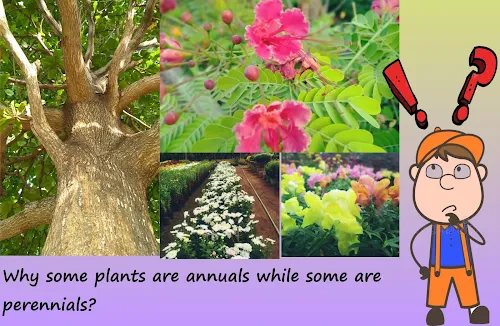The term “Life cycle” counts every event starting from single celled embryo till the organism reach its maturity and finally integrated into Mother Earth. The long journey is parted into various stages. Reproduction is a complex process by which all living beings on earth perpetuate their species.
Life cycle of flowering plants has different phases like seed germination, then seedling, plantlet and a mature plant. This covers the vegetative phase where all input is invested in building plant body. A transition of vegetative phase into reproductive phase is experienced by a surge in floral hormones. Pollination in flowers result in fruits having seeds that are dispersed by various agents. The dispersed seeds germinate and develop into a new mature plant.
Reproduction in plant kingdom is a scheduled process. Reproductive event is scheduled such that plantlets gain maximum chances of survival. This is with respect to competitors for sunlight, water, soil and low predator pressure from grazing animals.
Flowering plants are classified as annuals, perennials, biennials. This classification applies to herbaceous plants while woody trees lie in separate category. Annuals complete their life cycle in single season leaving seeds as dormant kernels. The entire plant body including leaves, roots and stems wither away. The seeds start next generation on advent of favorable environmental conditions. Annuals concentrate their entire energy in building the plant body, reproduction and amplifying their number. This behavior where an organism reproduces for single time throughout its life cycle is called monocarpic or semelparous. Biennials take two years to complete their life cycle. During the first year they grow having leaves in a rosette and during second year of their life cycle, energy is invested for stem elongation, blooming and bearing fruits. After flowering they die off. In contrast, perennials are long living plants and tend to blossom during short period in a particular season. This behavior where an organism reproduces multiple times during its lifetime is called polycarpic behavior. Life cycle of perennials lasts from three to five years. Perennials are best garden fences since the plant body survives over a long period and minimizes the replanting issues to gardeners.
Reproductive transit
Transition of vegetative phase to flowering is critical in angiosperms. Timeline for this transition changes with genus and is operated by a developmental switch. In annuals this developmental switch operates for a single time throughout their life cycle.
In plants, growth is not uniform and is concentrated in areas of meristem. On advent of flowering phase, apical meristems differentiate into floral tissues. The floral organs vary among different plant species. Few plants bear single flowers while few bear inflorescence.
In annuals like cereal crops, flowers are borne on inflorescence that develop to panicle bearing grains. The plant body starts to deteriorate as the panicle starts developing and sooner plant body senesces off.
Differentiation of apical meristem into inflorescence is suspected to switch alternative pathways promoting burning off the aerial plant parts. The possible reason for this programmed senescence could have been “big fatal” reproduction. Fecundity in monocarpic plants is at the maternal cost of investment. Most of the energy is invested in producing masses of offsprings. However, energy per individual offspring is always low and ignorable because of the high numbers borne on inflorescence.
This raised doubts on diversion of energy depots from apical growth towards building the floral set up. Metabolic pathways activated during flowering were well studied in the model plant Arabidopsis thaliana. It was observed that vegetative tissues were supplied the least energy and major part of energy resources are diverted as material supply for grain fill in panicles. Lipid mobilization, protein and nucleic acid hydrolysis were reported in somatic tissues of Arabidopsis thaliana post flowering. Fruit development might have been triggering a block in vascular supply so that somatic tissues are deprived of nutrients and result in senescence of aerial parts.
All the major cereals are annual crops. It is common that we notice farmers cutting heaps of grain filled panicles right from stem length and land is well ploughed for new season. If rice had been a perennial plant it would have decreased the ploughing, tilling, sowing cost for farmers but that never happens.
Transition of meristem is not the same in perennials as seen in annuals. Perennials maintain vegetative growth even after flowering. Flowering is not limited to single time. Either only selective meristems transform to floral organs or few meristems gain the ability to revert back as vegetative tissues after flowering. Enough knowledge about meristem allocation and reversion abilities is not known so far. Studies aiming meristem fate and underlying molecular mechanisms can be helpful in understanding reproductive strategies in evolutionary mechanisms of angiosperms.
Meristem transition studies in two close relatives of Brassicaceae
Arabidopsis thaliana and Arabidopsis alpina are members of Brassicaceae family with varied habits of flowering, one being monocarpic and other polycarpic respectively. Stems of A. thaliana wither away soon after its first flowering while A. alpina is a perennial. It was found that A. alpina retains some shoot apical meristems (SAM) from floral differentiation. Because A. alpina requires vernalization, researchers have even attempted to increase the time of vernalization so that all the SAM can undergo floral transition and turn to inflorescence.
An interesting observation was that few meristems refrained themselves and remained vegetative. It is well known that tissues retaining vegetative nature is not solely linked to cell division or growth. Tissues remain vegetative only if they maintain the vascular regularity. Perennials maintains connectivity with vascular bundles so the secondary growth is not hampered throughout their life time.
Choosing parity as a strategy to avoid climate extremes
Few researchers believe the existence of monocarpic and polycarpic states in nature as an adaptive strategy to avoid harsh environments.
Annual plants could have evolved from perennial plants as an adaptive strategy under unexpected climatic conditions. Extreme arid climate and frequent disturbances in localized ecology are believed to impose pressure on perennials to start annual behavior.
From plants perspective it is better to produce maximum possible offspring before the arrival of harsh season. Investing energy on next generation is better choice than investing the same on defense mechanisms. This could also be a possible reason for species variation in parities from different locations on earth.
Within the same species some variants are annual while some are perennials along different latitudes and longitudes of globe. For example, Snapdragon can survive as perennial in warmer regions while it is strict annual plant in polar regions in order to avoid harsh winter.
As a supportive factor for this strategy, biologists state that monocarpic behavior might have evolved in species having least chances of survival after reproduction. When the adult survival chances drop down, it’s worthy to invest maximum energy for the next generation so the species continuity is maintained.
This behavior is also noted in animals where the terminology differs saying it as semelparous and iteroparous. Few invertebrates, spiders, some species of marsupials are semelparous and die after reproduction. While iteroparous behavior defines a continued life time even after reproduction. However, iteroparous or perennial behavior (in case of plants) does not ensure a long life time.
For example, bamboo grows to its maximum size for years and flowers gregariously producing masses of fruits and finally aerial parts of plant deteriorate. Bamboo do not complete its life cycle in a year hence it is not an annual. Either it is not surviving after its first reproduction. So, being a perennial does not ensure the plant to produce multiple generations of offsprings in repeated cycles of reproduction. However, in the present case, bamboo plants mass blossom at same time giving dozens of fruits that are left even after being eaten by rodents and birds. Though the adult stalks and culms deteriorate there exists a guarantee for the new stalks to sprout out.
Although bamboo cannot be confused as semelparous, it does not ensure for being iteroparous too. It can be understood as prolonged semelparity or iteroparity on short term.
Nature holds a number of similar examples in cases of Agave, Yucca where plant body is perennial however flowering follows a monocarpic phenomenon. This cannot be confused as a continuance of life cycle from semelparity towards iteroparity. Studies so far have not been focused over this arena.
Plants are well known for showing phenotypic plasticity and semelparous species being iteroparous is common within species basing on the environmental conditions. Phenotypic plasticity is phenomenon of single genotype showing different phenotypes basing on the conditions prevailing.
Being monocarpic or polycarpic is dependent on the environment and surroundings also. Most trees of tropical rain forests complete multiple cycles of reproduction and live for hundreds of years.
If they had been annuals and produce masses of seeds in reproductive cycles it would have been difficult for the seeds to survive in conditions of high competition for sunlight under the thick canopy.
In case the parent plant is annual and perishes off after its first reproductive cycle and seeds would not germinate because of competition. This may result in the particular species loss from the entire ecosystem.
Nature’s reasons are always admirable, making rain forest trees as perennials is a part of nature drama for the survival and continuance of species.
Understanding theories of Nature has ever been fascinating. It gains lot of attention in knowing mechanisms underlying the clearly visible facts. Every species draws its own importance in its own perspective. Organisms aim for their primal survival and for the continuance of species. Studies on reproductive strategies and the mechanisms behind it help in understanding the evolutionary lines drawn over ages.


Good Information.
ReplyDeleteKeep posting these type of good information
Nice
ReplyDeleteNice contentz
ReplyDelete